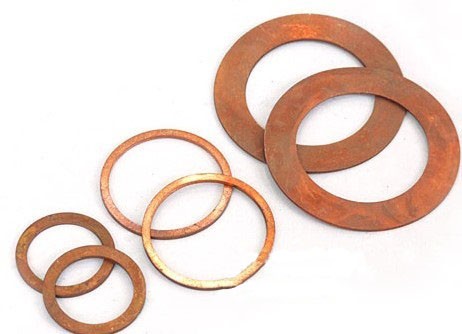
One of the primary benefits of solid copper gaskets is their softness. Copper is a malleable metal that can fit into the smallest spaces, creating a seal that doesn't leak under pressure. They can also withstand extremely high temperatures without breaking down or cracking, making them ideal for use in high heat environments. Additionally, solid copper gaskets have excellent electrical conductivity which is beneficial in electrical applications.
Copper gaskets are commonly used in the automotive, marine, aerospace, and construction industries. They are used in engine parts, transmission systems, exhaust systems, and other high-performance applications where they can withstand high temperatures and corrosive environments. Copper gaskets are also ideal for use in brewing and distilling equipment, food processing machinery, and HVAC systems.
There are mainly two types of solid copper gaskets, "flat" and "corrugated". Flat copper gaskets are used in applications where the surface contact is flat, while corrugated copper gaskets are used in applications where the contact surfaces are not flat, are warped, or have radial features such as bolt patterns. Corrugated copper gaskets can be crushed and re-used but flat copper gaskets tend to spread past their elastic limit upon initial use and cannot be re-used.
Copper gaskets are completely recyclable and are not harmful to the environment. Copper is abundant and widely available, so it's easy to source and produce. Copper itself does not emit harmful pollutants or chemicals, and the production process is safe and sustainable when environmentally conscious practices are followed.
It's essential to ensure that the surfaces being sealed are clean and free from debris before installing the copper gasket. Wipe the surfaces with a clean cloth and use an approved solvent to remove any remaining residue. Bolts, nuts, and washers should also be properly and evenly torqued to establish an even pressure to ensure secure sealing.
Solid copper gaskets are essential components in many high-performance applications, and their unique properties make them an ideal material for creating a strong, reliable seal between two surfaces. Copper gaskets offer high heat resistance, corrosion resistance, and sealability, making them ideal for use in a wide range of industries.
Ningbo Kaxite Sealing Materials Co., Ltd. is a leading manufacturer of solid copper gaskets, among other sealing products, based in China. The company produces and exports a wide range of sealing materials and products to countries worldwide. Contact Kaxite Sealing Materials Co., Ltd. via email at [email protected] or visit their website at https://www.top-seals.com to learn more.
1. S. Li, L. Wang, X. Wang, and H. Li, "Preparation of Copper Gasket Seal Using Friction Stir Processing Technology," Journal of Materials Science & Engineering, vol. 4, no. 6, pp. 98-105, 2019.
2. Y. Li, Z. Wei, and L. Wang, "The Effect of Copper Gasket Thickness on the Performance of the Bolted Joint," International Journal of Mechanical and Materials Engineering, vol. 7, no. 1, pp. 34-41, 2012.
3. V. Nair, M. Basheer, and K. Muraleedharan, "Effects of Surface Finish and Copper Gasket Thickness on the Performance of Bolted Joints," Metallurgical and Materials Transactions A, vol. 41, no. 7, pp. 1850-1861, 2010.
4. M. Hu, Y. Wu, and G. Yang, "Structure and Mechanical Properties of Copper Gaskets Reinforced with Graphene Oxide," Materials Chemistry and Physics, vol. 217, pp. 490-495, 2018.
5. T. Takahashi, T. Kato, and T. Hara, "High-temperature Sealing Performance of Copper Gaskets with Metal Coatings," Journal of Nuclear Materials, vol. 498, pp. 326-332, 2018.
6. G. Kim, S. Park, and S. Lee, "Performance Evaluation of Copper Gaskets with Different Surface Treatments for Use in Fuel Cell Systems," Materials Research Bulletin, vol. 68, pp. 194-199, 2015.
7. S. Lee, S. Kwon, and I. Jung, "Effect of Cladding on the Mechanical Properties and Microstructure of Copper Gaskets," Materials Science and Engineering A, vol. 540, pp. 82-89, 2012.
8. L. Wang, W. Li, and Y. Li, "The Characterization of Porous Copper Gasket Seal for High-temperature Polymer Electrolyte Membrane Fuel Cells," Journal of Power Sources, vol. 268, pp. 336-344, 2014.
9. M. Wu, Y. Du, and Y. Chen, "Application of a Coarse-grained Copper Gasket as a High-Temperature Seal in the Petrochemical Industry," Materials Science and Engineering A, vol. 651, pp. 552-560, 2016.
10. R. Alshemary, M. Ab. Rahman, and A. Alajerami, "Effect of Different Manufacturing Processes on the Mechanical and Physical Properties of Copper Gaskets," Procedia Manufacturing, vol. 41, pp. 150-156, 2020.
TradeManager
Skype
VKontakte
